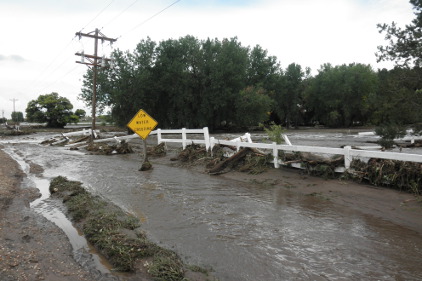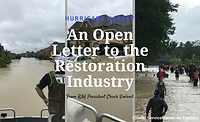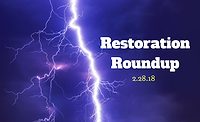An Open Letter to the Cleaning and Restoration Industry Regarding Recent Colorado Flooding
Introducing Boulder Flood Relief (BFR), an organization to mobilize support and provide aid in aftermath of Colorado flooding.

 The Colorado floods that you saw on the news have been described as “apocalyptic” by local residents. Boulder County and surrounding areas got about 20 inches of rain in four days - that’s roughly equivalent to getting the total annual amount of annual rainfall in less than a week!
The Colorado floods that you saw on the news have been described as “apocalyptic” by local residents. Boulder County and surrounding areas got about 20 inches of rain in four days - that’s roughly equivalent to getting the total annual amount of annual rainfall in less than a week!
The historic floodwaters ripped through and impacted 17 counties leaving behind eight fatalities. Adams, Arapahoe, Boulder Clear Creek, El Paso, Jefferson, Larimer, Logan and Weld Counties have been declared disaster areas, and one person is still missing or presumed dead.
The property damage is horrendous: 50 state bridges were damaged along with more than 200 miles of state highways and roads covering over 1,533 square miles. The Colorado Office of Emergency Management reported electric outages for 76 homes and natural gas outages for 1,282 homes, and more than 17,500 homes have been damaged or destroyed by the floods.
Our industry has stepped up. We responded promptly. You can’t drive down a street in the impacted area without seeing a restoration or cleaning company vehicle.
SteamMaster Restoration and Cleaning was there too. We mobilized our crews. We quickly moved to assist homes and businesses helping to mitigate the water damage. We work closely with our vendors and suppliers, and we exchanged friendly greetings with our competitors.
Over the years, our industry has mobilized rapidly to respond to natural disasters: flooding, hurricanes, tornadoes, wildfires, wind and hail storms. We watch the weather more intently than the average person.
We have the know-how. We understand the science of mitigation and restoration. We have the necessary tools and equipment, no matter how great the loss. We are protected with all the necessary immunizations to work safely. This is who we are and this is what we do best. We are always ready with crews, trailers full of equipment and mobile offices, and some of us travel across the country to respond.
Our supply vendors, equipment rental companies and third-party administrators are equally prepared. They remain ready to respond and able to deploy help to disaster-stricken areas when needed.
Next to the first responders who are out saving lives, we are always there next in line. As we provide emergency response, mitigating and restoring both residential and commercial properties, our crews are equipped mentally and physically. We know how to show the proper demeanor, how to show empathy to those who are experiencing shock and grief.
We respond because we care. And we do this because this is what we do. We also do this because this is our livelihood. We respond to disasters because it pays the bills and keeps our workers and staff employed. We respond to disasters because it drives our businesses profitability, and it sustains us yet another year.
Like the first responders, we pray that disasters and emergencies won’t happen. But emergencies and disasters do happen, and we have responded many times, to many natural disasters, over the years.
When Superstorm Sandy hit New Jersey earlier this year, a noble and commendable grassroots disaster relief network sprung up to provide mutual aid to communities affected by the massive storm. They pioneered a volunteer movement and mobilized to help anyone who needed help.
We are currently providing restoration and cleaning services to customers who hired us during the Colorado floods. Alongside our efforts, a group volunteers called Boulder Flood Relief (BFR) has formed to mobilize and provide aid for those who are still in need.
Boulder Flood Relief was started by veterans of the “occupy” movement and includes many University of Colorado at Boulder students among its volunteers. CU PhD candidate Meghan Dunn, one of the founding organizers, spent nine months working with and researching emergency response techniques used in New York during Occupy Sandy storm relief.
In less than two weeks, BFR has built a volunteer database of over 3,000 individuals. It has completed more than 150 volunteer-assisted projects, and is currently working in several neighborhoods based on requests and needs.
But ironically, many, if not most, governmental and charitable relief organizations cannot or do not use volunteers. The need remains acute: Colorado’s Office of Emergency Management says that the floods destroyed 1,882 homes and damaged 17,500, damaging or destroying 968 businesses as well. (These numbers change daily, as first responders reach cut-off areas and report additional victims and damage.)
BFR’s core group is working out of office space donated by Applied Trust IT consulting on Walnut Street in Boulder. The tech-savvy group is using Facebook, Twitter, Google Plus and other Internet tools to reach volunteers and victims, and it has launched an online peer-to-peer marketplaceof goods and services that will allow flood victims to self-organize and recover.
As I write this, some restoration and cleaning companies have completed their work and returned to their businesses, but the need to assist residents struggling with flooded and damaged homes remains vast. Most victims did not have flood insurance, and neither FEMA nor insurance payments will cover more than a small fraction of their losses.
In the coming weeks, Boulder Flood Relief will continue to recruit and assign volunteers. As winter approaches, the need for support will intensify. Please join me in sending donations in kind or monetary support to BFR via the www.BoulderFloodRelief.org website.
Those interested in volunteering should:
· See BFR’s Facebook page or Twitter @boulderflood and #boulderfloodrelief for news and announcements.
· Sign up to volunteer at www.boulderfloodrelief.org.
As a member of the restoration industry, I seek your help to support those who are still filling an enormous need. BFR is a volunteer group that has its boots on the ground – or more often, in stinking mud. Please send me an e-mail (raj@steammaster.com) with what you can do to help them and those whose lives have been deluged by the floods.
Looking for a reprint of this article?
From high-res PDFs to custom plaques, order your copy today!








